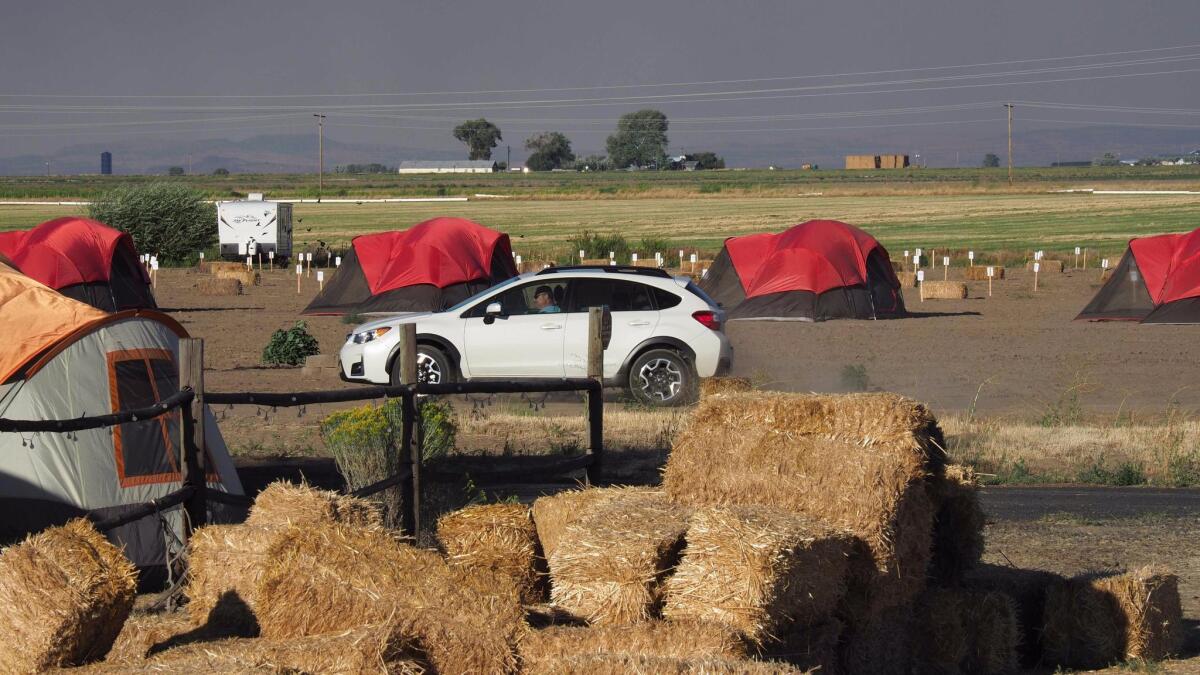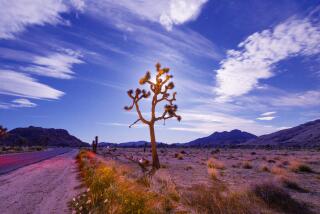As eclipse looms, states brace for traffic gridlock

Reporting from Dillard, Ga. — Most weekdays, a steady stream of cars and pickups winds down U.S. Route 441 through this tiny mountain town.
Locals stop to stock up on bread and eggs at the Piggly Wiggly. Tourists browse a string of antique stores. Nearly everyone pulls over at the Osage Farm stand to pick up ripe peaches, silver queen corn and heirloom tomatoes.
This Monday will be different.
Dillard, population 330, is the prime spot in Georgia for viewing the first total solar eclipse in 99 years to sweep the continental U.S. The town sits in the Appalachian foothills north of Rabun County, where authorities expect an extra 50,000 cars on its two narrow highways and small state and county roads.
“There’s no way tens of thousands of extra cars can pass this skinny road going up the mountain,” said Louis Meinhardt, 74, a resident of nearby Scaly Mountain, N.C. “Just one accident and everyone will be backed up for miles.”
Local sheriffs and highway patrol officers from across the country are bracing for what they say could be the largest traffic snarl in U.S. history as the so-called Great American Eclipse cuts a diagonal, 70-mile-wide path through 14 states from Oregon to South Carolina.
With 200 million people living within a day’s drive of that path, millions are expected to travel from urban hubs to sparsely populated, rural areas on narrow state and county roads that are poorly equipped to handle massive traffic.
“Imagine 20 Woodstock festivals occurring simultaneously across the nation,” Michael Zeiler, a geographer and cartographer, wrote on GreatAmericanEclipse.com. He estimated that up to 7.4 million people across the country could attempt to travel to the path of totality.
In 1918, the last time a total solar eclipse swept across the U.S., there were about 6.2 million cars registered nationwide, said Doug Hecox, spokesman for the Federal Highway Administration. Today, there are 263 million.
Ultimately, Hecox said, traffic experts do not know what to expect.
“I would love to say this is as significant an event as 15 Super Bowls all combined, but we don’t really have good baseline data to compare it against,” he said.
“We know there could be traffic jams in places that have never seen a traffic jam,” Hecox said. “It’s just basic math. The risk of a crash or a driver being distracted, or hitting another car or a pedestrian or a bicyclist, is considerably greater today than it was a hundred years ago.”
In Oregon, where the eclipse first comes into view at 9:04 a.m. — with the full eclipse at 10:16 a.m. — near the town of Depoe Bay, the biggest traffic problems are expected in the central part of the state.
Traffic was already backed up for miles on U.S. Highway 26 on Wednesday night when visitors flocked to an eclipse-themed festival in the tiny high desert town of Madras. Locals are expecting up to 100,000 visitors.
“Just know, there will be delays,” said Peter Murphy, a spokesman for the Oregon Department of Transportation. “We’re two lane roads up here and it’s going to get clogged up.”
In Wyoming, which has just under 600,000 residents, tourism officials anticipate at least 350,000 visitors. Grand Teton National Park, in the state’s rugged, northwestern corner, could have its busiest day in history.

Eclipse chasers will tell you that seeing a total eclipse will change your life. But keep in mind, a total eclipse is a fleeting phenomenon. (Aug. 15, 2017) (Sign up for our free video newsletter here http://bit.ly/2n6VKPR)
South Carolina is expected to be one of the most crowded destinations, with estimates ranging from 600,000 to 2 million visitors. The state Highway Patrol plans to station 160 extra officers along Interstate 26 and nearby roads Monday as the eclipse passes three of the state’s biggest cities: Columbia, Greenville and Charleston.
But the most crowded hot spot in the country, according to Zeiler, could be Santee, a resort town in central South Carolina that has roughly 900 residents. Its proximity to I-95 makes it the closest destination for 74.6 million people from Florida to Maine.
Even in states outside the path of totality, officials are warning motorists to expect delays of more than several hours.
In Colorado, state officials estimate as many as 400,000 residents could travel to Wyoming and Nebraska, snarling traffic on I-25 and all roads heading north.
Officials across the nation have been planning for months to ease congestion.
The Federal Highway Administration is instructing drivers to leave plenty of time to avoid being stuck in traffic during the eclipse and warning them not to stop in the middle of highways or on the shoulders.
“We want to make sure people don’t make rookie mistakes, like driving with eclipse glasses or taking photographs while driving,” Hecox said.
In Rabun County, where a few stretches of the main interstate narrow to just one lane, pastures are being turned into parking lots, and extra sheriff’s deputies from neighboring counties and highway patrol officers are being brought in to manage congestion.
“We’ve never had anything like the amount of traffic it will bring to our area,” said Sheriff Chad Nichols, who has urged locals to prepare as they would for a snowstorm. “The main question is where will people go? Will the main road turn into a parking lot?”
Mike Brown, owner of 12 Spies Vineyards in Rabun Gap, has warned guests coming from as far afield as Arizona, California and New Jersey to expect delays and be patient as they traverse local roads.
“We’re expecting Atlanta traffic, but we don’t have Atlanta roads,” he said.
While Rabun County is home to several state parks with mountain trails and sweeping vistas, tourism officials here note that parking is limited and first-come, first-served.
“What people love about the mountains is that there are not a lot of flat, cemented places,” said Teka Earnhardt, executive director of Rabun County Tourism Development Authority. “They do not have a lot of parking — that’s their beauty.”
Many residents said they plan to stay home and avoid the roads at all cost.
“I don’t like crowds that much,” shrugged Belinda Turpin, a 49-year-old medical assistant, as she filled her Toyota Camry with gas at a BP station advertising “eclipse tailgating.” “I’m not that curious.”
Still, Turpin has to make it to her 3 p.m. shift at an assisted living facility just minutes before the eclipse passes through her home town of Clayton. It’s normally a five-minute drive.
“I’ll take the back roads and hope for the best,” she said. “Maybe I’ll go to work early.”
Special correspondent Jarvie reported from Georgia. Times staff writer Lee reported from Los Angeles.
Twitter: @kurtisalee
ALSO
Eclipse prompts California power grid changes when solar energy supply dips
How to watch the Great American Eclipse live online
There’s still time to get eclipse glasses — but you’d better act fast
More to Read
Sign up for Essential California
The most important California stories and recommendations in your inbox every morning.
You may occasionally receive promotional content from the Los Angeles Times.












